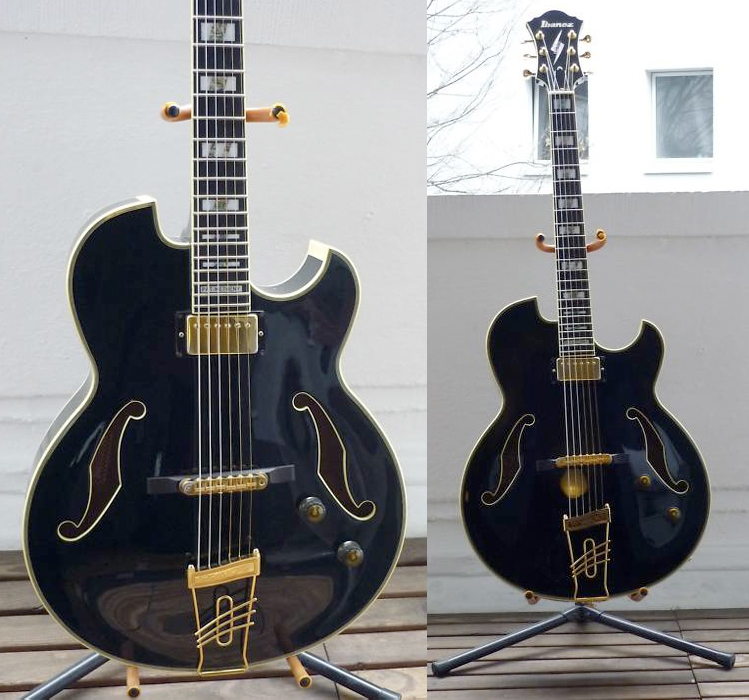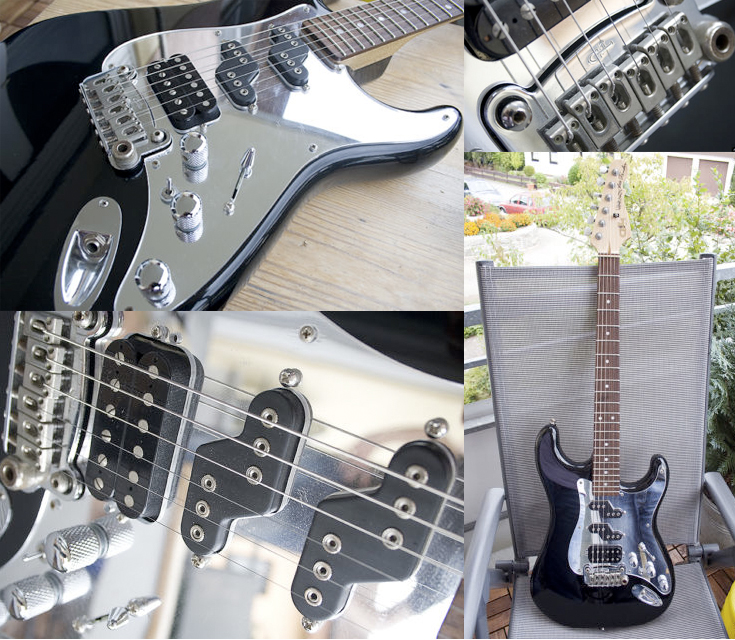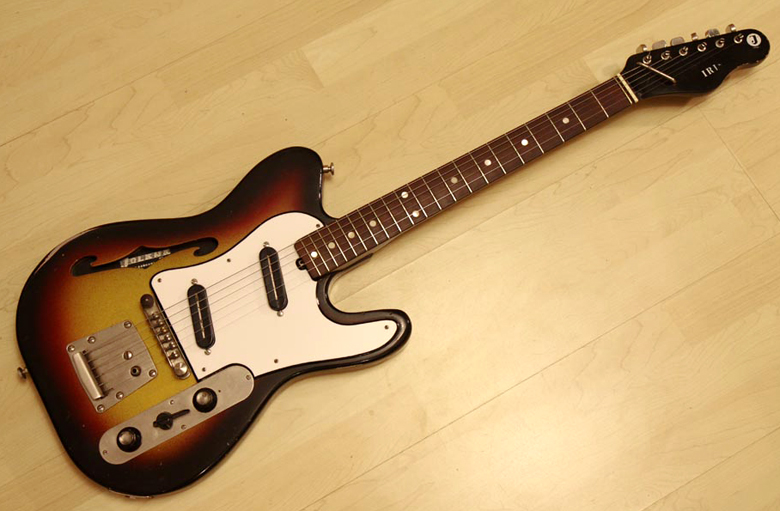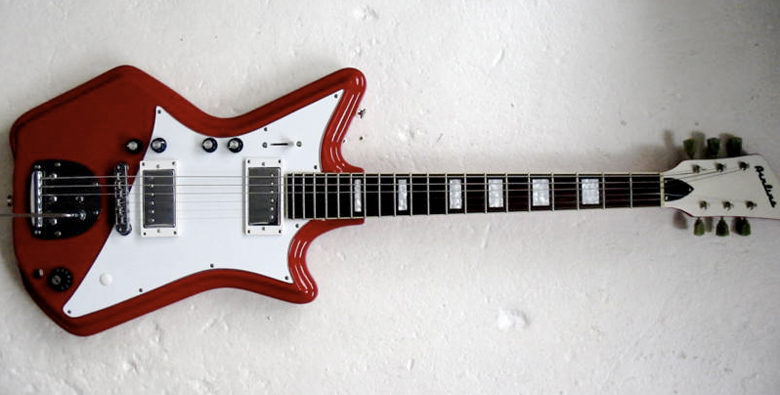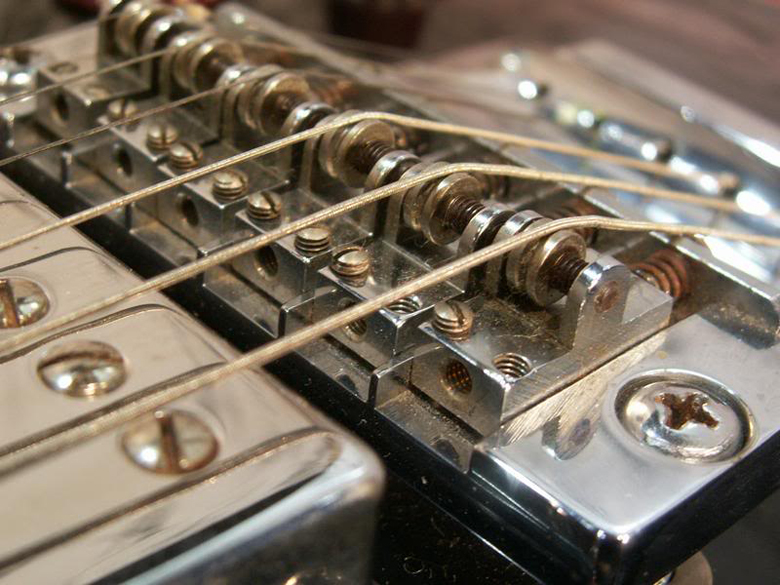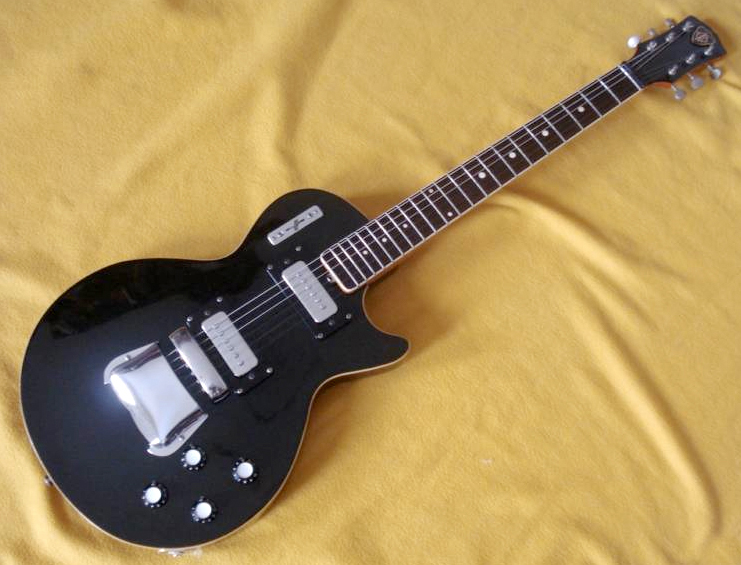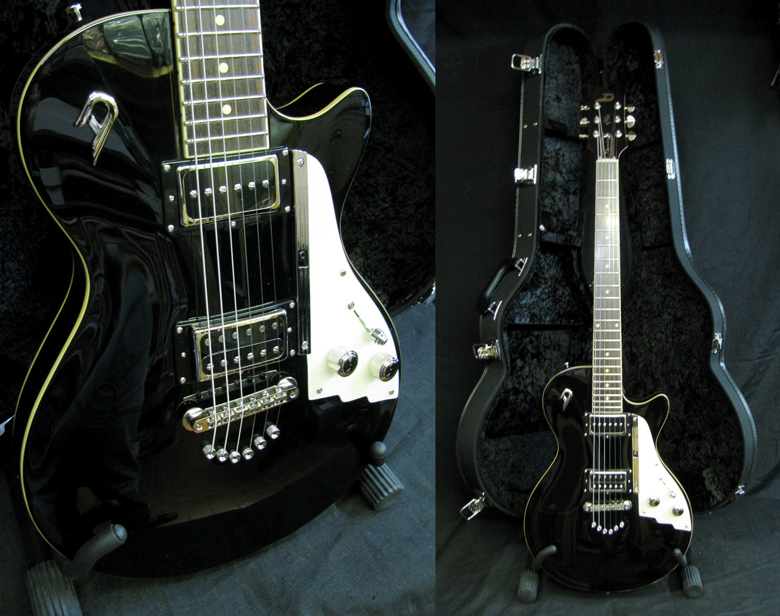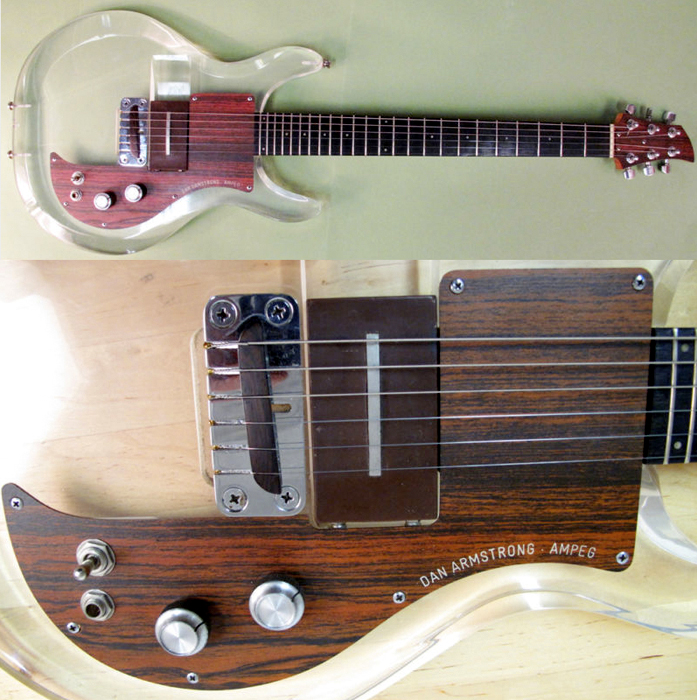Sunday, 28 February 2010
Ibanez PM100 Pat Metheny Signature
Vintage one-off violin guitar
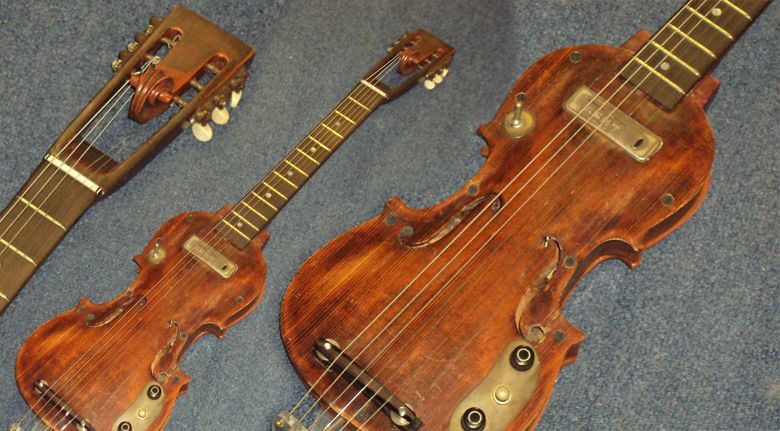 We've all seen guitars and basses styled after violins, but this one-off hand-built violin guitar would appear to use an actual violin body, or at least a very close approximation of one. Notice how because of the diminutive body size the bridge is positioned as far back as it can go while the tailpiece is off the end of the body on an extension (which reminds me of a similar feature on the original Ampeg AUB-1 "scroll" bass).
We've all seen guitars and basses styled after violins, but this one-off hand-built violin guitar would appear to use an actual violin body, or at least a very close approximation of one. Notice how because of the diminutive body size the bridge is positioned as far back as it can go while the tailpiece is off the end of the body on an extension (which reminds me of a similar feature on the original Ampeg AUB-1 "scroll" bass).
The headstock design is also very interesting, and features an inverted violin-like scroll in the centre. Someone put a lot of effort into this guitar.
The neck is very short and joins the body at the twelfth fret. In fact, there are ONLY twelve frets in total. If you like playing up at the top of the neck forget it! I guess it wouldn't appeal to many modern players.
Nevertheless it's a fascinating piece and worthy of our attention here at Guitarz.
G L Wilson
NB: Please make sure you are reading this Guitarz post at guitarz.blogspot.com and not on a Scraper blog that copies posts without permission (and steals bandwidth) so as to profit from advertising. Please support original bloggers!
Saturday, 27 February 2010
Tony Paris Pentachord with 30 strings
 guitarz.blogspot.com:
guitarz.blogspot.com:When I first saw this instrument listed in the guitars section of eBay I mistook it for a hammer dulcimer, and thought that the seller must had been listed it in the wrong section. But on closer inspection, it is indeed a relative of the guitar.
Apparently it is a Pentachord, manufactured by Tony Paris. It has five sets of six strings - equivalent to five guitars. From what I can work out each bank of strings can be tuned to an open chord. The movable nut for each bank of strings allows for further chord options.
I guess you could set this up for each of the chords you'd require for a particular song (depending on the number of chords in the song, of course) and strum along on the relevant bank of strings as and when required. If a song has more than five chords, it might be possible to effect a quick chord change on the fly by moving one of the movable nuts.
G L Wilson
NB: Please make sure you are reading this Guitarz post at guitarz.blogspot.com and not on a Scraper blog that copies posts without permission (and steals bandwidth) so as to profit from advertising. Please support original bloggers!
40s Gretsch Synchromatic with De Armond custom pickup

NB: Please make sure you are reading this Guitarz post at guitarz.blogspot.com and not on a Scraper blog that copies posts without permission (and steals bandwidth) so as to profit from advertising. Please support original bloggers!
G&L Legacy Custom
Thursday, 25 February 2010
An incompetently-designed harp guitar (I think that's what it's supposed to be)
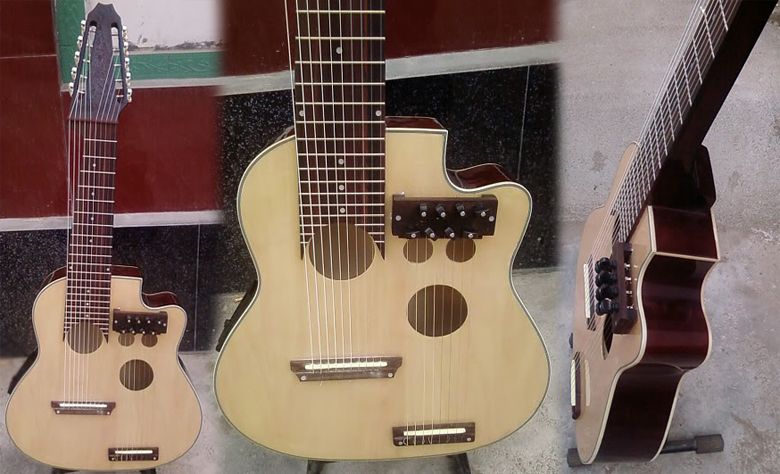 Oh no, this is just dreadful. It's another one of those cheaply cobbled-together Chinese-made guitars that pay very little consideration to the playabilty or practicality of an instrument.
Oh no, this is just dreadful. It's another one of those cheaply cobbled-together Chinese-made guitars that pay very little consideration to the playabilty or practicality of an instrument.I'm not sure where to start... This appears to have extra strings just for the fun of it. Now, I know that some acoustics carrying additional strings will have "sub bass" strings that are positioned outside of the neck as they are intended to be played open, harp-style, but on this neck it looks like they couldn't decide if the bass strings should be over the fingerboard or not, so we've got a little bit of both on a very strangely shaped neck.
Speaking of neck shape, just look at the back of it. It must be square in cross-section. It doesn't look very playable.
I can't imagine how useful the other eight strings mounted on the body are. I guess you could have them tuned them to a chord. I'm also not convinced about the location of the tuners mounted in that little box on the front of the soundboard. Wouldn't it damp the vibrations of the top? Wouldn't it rattle?
But the thing that bugs me the most about this sorry effort of a guitar, is the cutaway on the body. The whole point of a cutaway on a guitar is to facilitate playing on the higher frets of the guitar at the body end of the fingerboard. But here, the cutaway is nowhere near the neck and therefore useless. What is the point? Not only is it without function, it also looks absolutely appalling.
I'm reminded of those dreadful Tennessee-brand guitars, and suspect that this guitar may originate from the same source.
G L Wilson
NB: Please make sure you are reading this Guitarz post at guitarz.blogspot.com and not on a Scraper blog that copies posts without permission (and steals bandwidth) so as to profit from advertising. Please support original bloggers!
McPherson Jumbo Acoustic
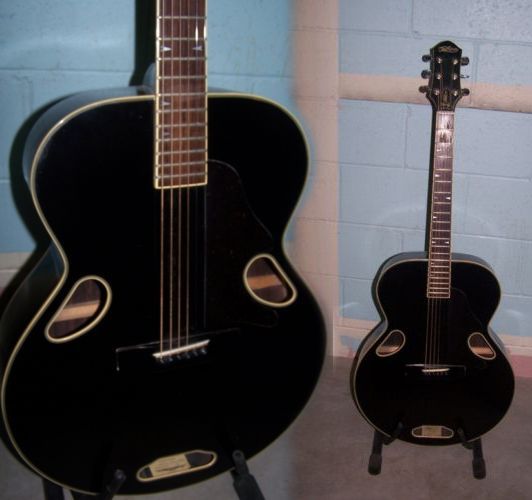 guitarz.blogspot.com:
guitarz.blogspot.com:Following on from Bertram's recent post about a Hoyer Jazz guitar with triple soundholes, here is another guitar with an unusual configuration of three soundholes. Appparently, it is a Japanese-made McPherson jumbo acoustic (this example is currently being offered for sale on eBay). Other than that, I'm afraid I know nothing about it.
As ever, if anyone reading has any additional information, please use the comments below this post. Thanks.
G L Wilson
NB: Please make sure you are reading this Guitarz post at guitarz.blogspot.com and not on a Scraper blog that copies posts without permission (and steals bandwidth) so as to profit from advertising. Please support original bloggers!
Stephen O'Malley of Sunn O))) and Travis Bean aluminium-necked guitars
 Here's a recent email from Gary:
Here's a recent email from Gary: I've been a religious follower of your blog the past couple years and I have a problem here that I'm sure you're used to getting millions of e-mails a day about. I've attached some pictures of a guitar played by Stephen O'Malley of Sunn O))) and many other droney, experimentaly type projects. Note the T-shaped cutout on the headstock. It also appears that it has an aluminum bolt-on neck with a large tongue that fits into the body. And are the strings through the body and into the tongue (essentially the neck itself)? I don't see myself as anything close to an expert on guitar design but couldn't that offer some massive sustain? I recently bet a friend of mine that I could find out what it was before him so any help whatsoever would be greatly appreciated. And any insights you might have into the guitars design (like me being ridiculously wrong for example) would be awesome.Hi Gary
It's a Travis Bean - which were a forerunner to the metal-necked Kramers. You are quite correct about the construction of the guitar and yes - they are known for their massive sustain.
See the Guitarz archives for a Travis Bean "display guitar" (that looks cruelly butchered) and a little bit of info.
There's also a TB1000S on eBay right now:
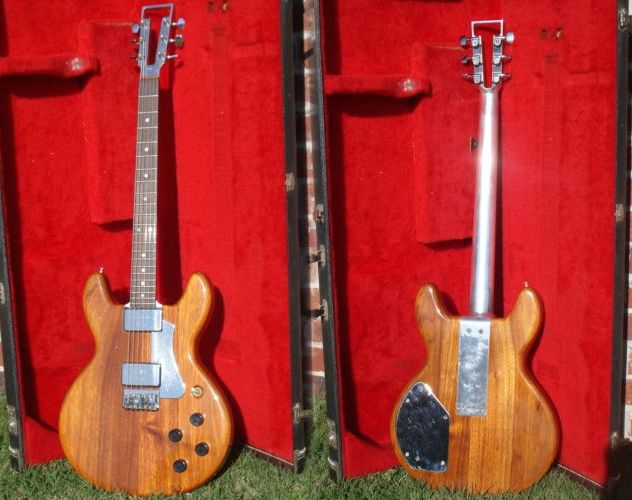 Thin Lizzy's Brian Robertson can be seen playing a Travis Bean in some of the band's videos from the 1970s. I'm pretty sure that Bill Wyman played a Travis Bean bass in the Stones for a while too.
Thin Lizzy's Brian Robertson can be seen playing a Travis Bean in some of the band's videos from the 1970s. I'm pretty sure that Bill Wyman played a Travis Bean bass in the Stones for a while too.G L Wilson
NB: Please make sure you are reading this Guitarz post at guitarz.blogspot.com and not on a Scraper blog that copies posts without permission (and steals bandwidth) so as to profit from advertising. Please support original bloggers!
Elgava Unika-2 Soviet vintage electric guitar
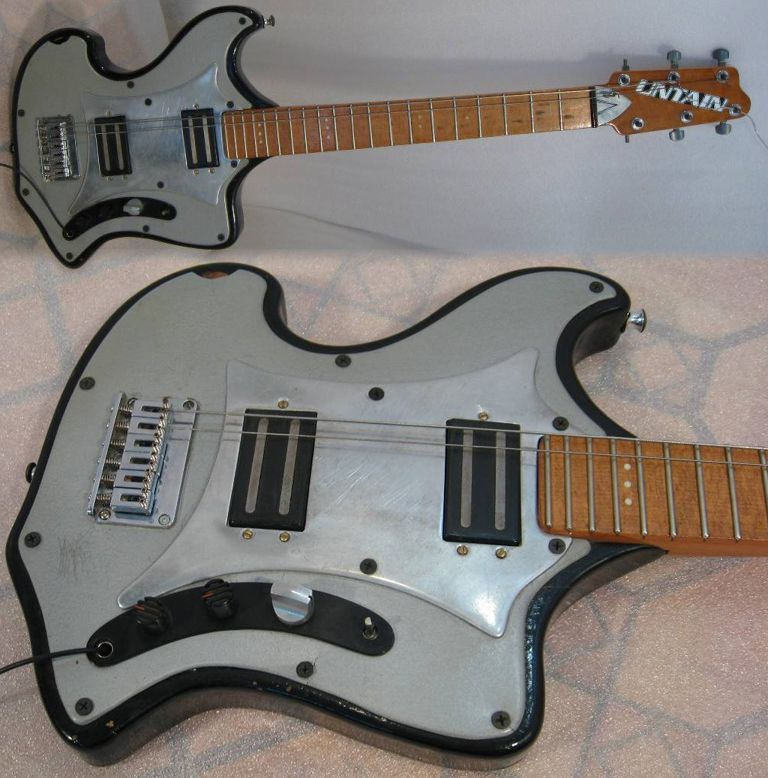 This rather eccentric-looking guitar was recently offered for sale on eBay, courtesy of a seller specialising in old East European and Russian guitars, whose guitars we have featured on this blog previously. (Possibly you could dedicate a whole blog exclusively to such guitars).
This rather eccentric-looking guitar was recently offered for sale on eBay, courtesy of a seller specialising in old East European and Russian guitars, whose guitars we have featured on this blog previously. (Possibly you could dedicate a whole blog exclusively to such guitars).Unfortunately practically zero information is given about this instrument, other than a name - Elgava Unika-2 - which is contradicted by the "Untain" legend on the headstock. The name "SAMOPAL" is also given, but not explained.
The guitar itself is a typically crude example. The front of the body is faced with what looks like a metal plate, although I wouldn't be surprised if this was actually plastic, seeing as part of it has been snapped off. The body is very likely hollow within. Note how the guitar lead is wired straight into the guitar, which is probably slightly more convenient than having to mess about finding a guitar lead with a 5-pin DIN plug as with other of this guitar's contemporaries.
I wouldn't honestly expect this guitar to be a good player - the seller rather astutely declines to guarantee its playability. This is one for the collector of the weird and unusual.
G L Wilson
NB: Please make sure you are reading this Guitarz post at guitarz.blogspot.com and not on a Scraper blog that copies posts without permission (and steals bandwidth) so as to profit from advertising. Please support original bloggers!
Wednesday, 24 February 2010
Ceramic-bodied acoustic guitar
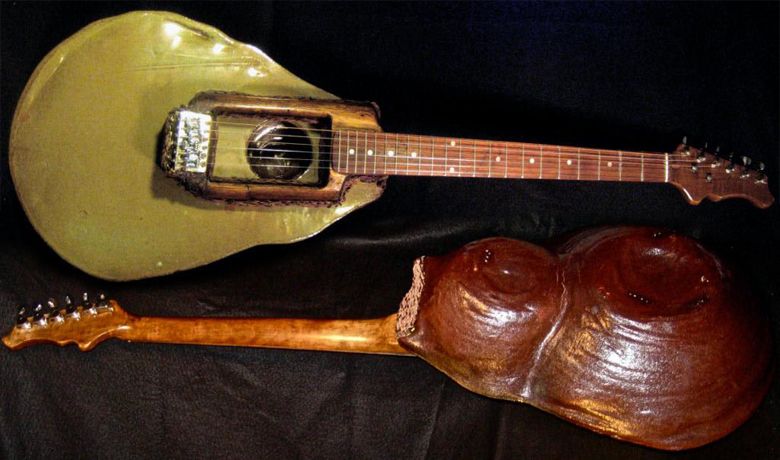 From the listing on eBay:
From the listing on eBay: "This ceramic guitar was built by Gabe Turow, of www.StoneInstruments.com. Over the course of two months the ceramic guitar was born: with the sound of a steel guitar mixed with the plunkiness of a banjo, this guitar is a total trip. The body is ceramic and the neck is oak. The body was constructed by throwing two bowls on the wheel, joining them, and then securing the neck onto the resonator with construction-grade adhesive. The headstock was hand-carved. The guitar comes with an audiophile-quality piezo-electric 1/2"X2" tape microphone and 1/4" input jack for amplification."
An intersting concept. Here's a YouTube video to explain the construction process:
G L Wilson
NB: Please make sure you are reading this Guitarz post at guitarz.blogspot.com and not on a Scraper blog that copies posts without permission (and steals bandwidth) so as to profit from advertising. Please support original bloggers!
Norma EG-400 solidbody electric from the late 1960s
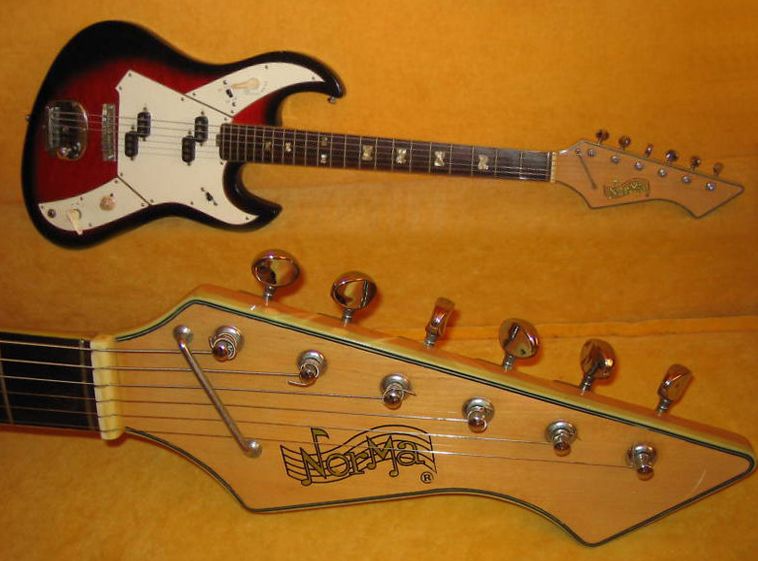 Here's an unusual one: it's a Norma EG-400, circa 1967, built by the Tombo Instrument company in Japan and imported into the US by Strum & Drum of Chicago. Aside from having the tremolo arm missing, this guitar appears to be in remarkably good condition for its age. One nice little detail is that the fingerboard inlays are appropriately "N"-shaped. Except that, sideways-on they look "Z"-shaped.
Here's an unusual one: it's a Norma EG-400, circa 1967, built by the Tombo Instrument company in Japan and imported into the US by Strum & Drum of Chicago. Aside from having the tremolo arm missing, this guitar appears to be in remarkably good condition for its age. One nice little detail is that the fingerboard inlays are appropriately "N"-shaped. Except that, sideways-on they look "Z"-shaped.Note the unusual arrangement of four three-string pickups. You can see the available switching options in the photos reproduced below. Other controls include a 3-position tone selector switch.
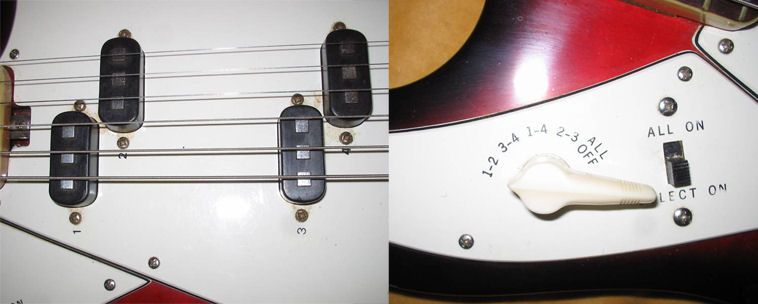 Thanks to David Brown who spotted this guitar on eBay.
Thanks to David Brown who spotted this guitar on eBay.G L Wilson
NB: Please make sure you are reading this Guitarz post at guitarz.blogspot.com and not on a Scraper blog that copies posts without permission (and steals bandwidth) so as to profit from advertising. Please support original bloggers!
Martin Guitar donates $20,000 one-of-a-kind guitar to Christie's for 2010 inaugural "Green Auction"
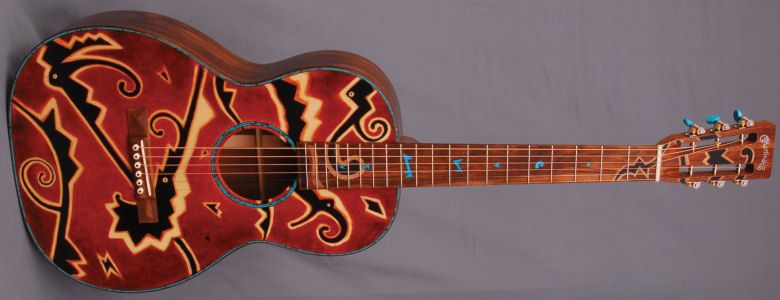 [NB: I don't normally like posting press releases here on Guitarz, but the notion of a guitar being worth $20,000, whilst quite obscene, makes it worthy of mention. It's a stunning looking guitar too - and so it should be! At least Martin are doing the right thing with their donation to this auction. - GLW]
[NB: I don't normally like posting press releases here on Guitarz, but the notion of a guitar being worth $20,000, whilst quite obscene, makes it worthy of mention. It's a stunning looking guitar too - and so it should be! At least Martin are doing the right thing with their donation to this auction. - GLW] STAR-STUDDED EVENT TO BE HELD ON EARTH DAY, APRIL 22
PROCEEDS FROM AUCTION TO BENEFIT CONSERVATION INTERNATIONAL, OCEANA, NATURAL RESOURCES DEFENSE COUNCIL AND THE CENTRAL PARK CONSERVANCY
[That's enough upper case now, thanks. - GLW]
Nazareth, PA – February 22, 2010 – In tune with Martin Guitar’s environmental philosophy, C.F. Martin & Co. has donated a rare 000 12-fret Peter Cree Certified Wood Guitar (photo attached) to Christie’s International, the world’s leading art business, for their upcoming “A Bid to Save the Earth” Green Auction.
This first-of-its-kind charity auction will take place on April 22, 2010 to coincide with the 40th anniversary of Earth Day. Proceeds from the sale will be divided among four leading not-for-profit environmental organizations: Conservation International, Oceana, Natural Resources Defense Council and the Central Park Conservancy. All four beneficiary organizations are 4-Star rated by CharityNavigator.org, its highest rating for not-for-profit organizations.
Estimated in value at $20,000, the one-of-a-kind Martin Custom Shop 000 12-fret Peter Cree Certified Wood Guitar features original Southwestern artwork executed in hand-applied colored lacquers by renowned painter/sculptor Peter Cree. Known for developing and incorporating a decorative finishing technique intended for high-quality acoustic instruments, Cree’s work has been highly sought-after across the country for his creation of new pieces, as well as his expert restorations of fine art and instruments.
Constructed with 100% Certified tonewoods from ecologically well-managed forests, the 000 12-fret Peter Cree Certified Wood Guitar features Chechen headplate, back and sides; a four-piece Adirondack top; Katalox fingerboard and bridge; cherry neck, front and rear block; basswood ribbon linings and braces; and artistic inlays of Micarta, cherry and turquoise.
“For nearly two decades, we at Martin Guitar have been devoted to pioneering a movement of ecological responsibility within the guitar industry,” said Chris Martin IV. “C.F. Martin & Co. is proud to have contributed such an artistically creative and ecologically symbolic instrument in support of charitable environmental initiatives through this special Christie's auction.”
Held at Christie’s, Rockefeller Center, New York and carried live globally via Christie’s LIVE™ on www.christies.com.The Evening Sale will be a star-studded event with top celebrities serving on the Green Auction Host Committee that includes: Leonardo DiCaprio, Harrison Ford, Tobey Maguire, François-Henri Pinault, Salma Hayek, Bob Fisher, Candice Bergen, Ed Norton, Evelyn Lauder, Alec Baldwin, Zaha Hadid, Brooke Shields, and Matt Lauer. Additional lots for auction will include major works from artists, coveted celebrity experiences, upscale eco-vacations and exquisite jewelry.
NB: Please make sure you are reading this Guitarz post at guitarz.blogspot.com and not on a Scraper blog that copies posts without permission (and steals bandwidth) so as to profit from advertising. Please support original bloggers!
Tuesday, 23 February 2010
Gittler Guitar
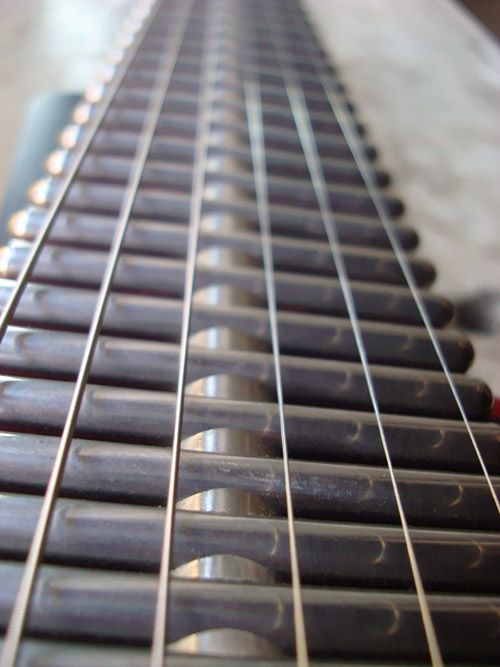 guitarz.blogspot.com:
guitarz.blogspot.com:The original handmade Gittler guitar was an object lesson in minimalism. Here was something that looked like a cross between a metal fish skeleton and a TV aerial, yet is was actually a fully-functioning guitar.
The design not only dispensed with the headstock but even the bulk of the neck itself. The neck was simply a steel rod supporting a series of smaller steel rods acting as frets. What there was of the body consisted mainly of six steel rods running beneath the strings. Each of these contained a pickup - one for each string allowing for interesting stereo and panning options.
Original examples were built by Alan Gittler in the late 1970s. In the early 1980s, production instruments were built in Israel by the Bar Rashi company founded by Alan Gittler. There were two models, both of which now had small plastic-resin bodies containing the electronics, whilst one model had the same plastic material forming a "back" to the neck. This latter version is the one we see pictured here and an example of which was recently offered for sale on eBay. For a picture of the version without the plastic neck back, I refer you to pp.140-141 of 500 Guitars (another little plug there!).
 I was fortunate enough to be able to try out each of these models soon after they went into production back in the day. You'd imagine that the model with the plastic material behind the neck would be easier to play. It wasn't. It just made for an uncomfortable, bulky neck. Aesthetically it's not as nice either.
I was fortunate enough to be able to try out each of these models soon after they went into production back in the day. You'd imagine that the model with the plastic material behind the neck would be easier to play. It wasn't. It just made for an uncomfortable, bulky neck. Aesthetically it's not as nice either.However, the other version - the proper fish skeleton model - I loved.
It wouldn't be a good guitar for shredding on, and I think you'd need to adapt your playing style especially for the instrument. For starters, you need to have the thumb of your left hand firmly on the back of the neck in a classical playing position. I saw one guy trying it out who insisted on wrapping his thumb over the top, Hendrix-style, and that just didn't work. Possibly, you could use this as a tap-style instrument. I think it's one that you need to approach with fingers lightly floating over the frets (I can't say "fretboard" because there isn't one!). It's not a neck you are able to hold, as such.
Alternatively you could view it as the utlimate in scalloping!
If you want to see one in use, most people will point you in the direction of the video of "Synchronicity II" by The Police, but here Andy Summers is merely using his (pre-production) Gittler as a prop. The only example I can find of someone genuinely playing a Gittler is here.
G L Wilson
NB: Please make sure you are reading this Guitarz post at guitarz.blogspot.com and not on a Scraper blog that copies posts without permission (and steals bandwidth) so as to profit from advertising. Please support original bloggers!
Gretsch New Jet 6114
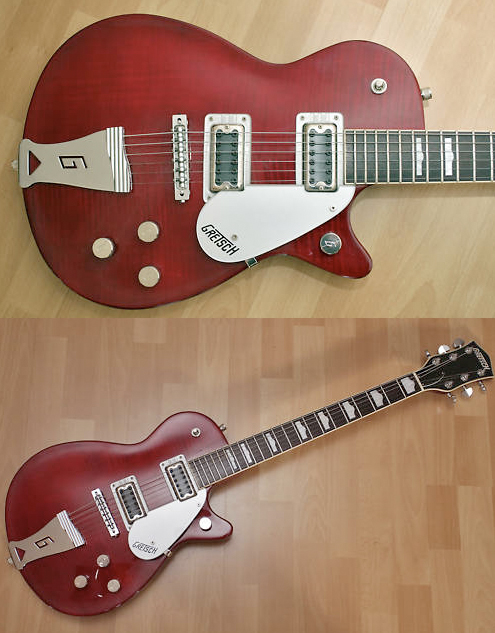
NB: Please make sure you are reading this Guitarz post at guitarz.blogspot.com and not on a Scraper blog that copies posts without permission (and steals bandwidth) so as to profit from advertising. Please support original bloggers!
Monday, 22 February 2010
BC Glass Studios Fused Glass Guitar
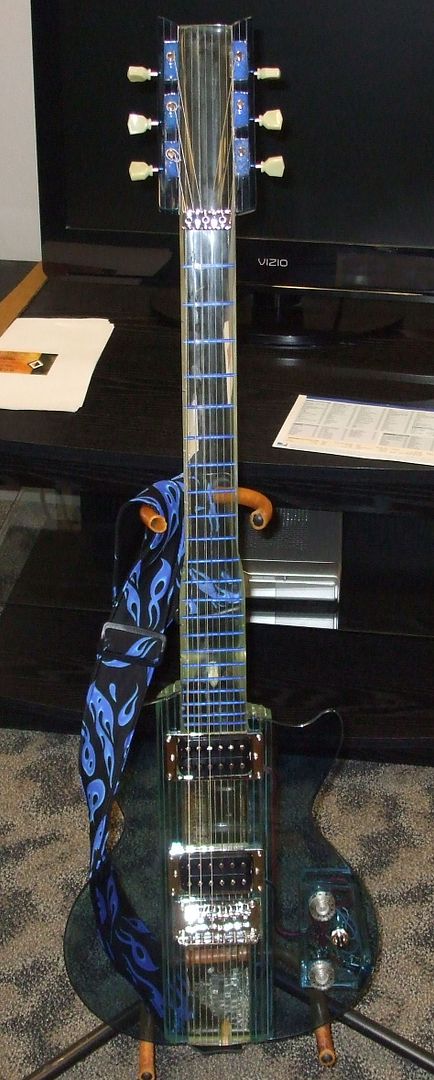 guitarz.blogspot.com:
guitarz.blogspot.com:We've all seen see-through acrylic-bodied guitars before. However, I want to stress that is NOT what we are looking at here.
Back in June 2007 I made a one-line entry on this blog with a link to BC Glass Studio. My comment at the time was that:
"BC Glass Studio make custom handmade one-of-a-kind fused glass guitars. Which you can't play - these are sculptures."Well, all that has changed!
Brian Chivers, the guy behind BC Glass Studio of Weukesha, Wisconsin, accepted a challenge from the legendary, and now sadly departed, Les Paul to "build one you can play". Pictured here is the result.
This is another of the 500 Guitars listed in the book of the same name. Whilst that sounds like a deliberate plug, I mention it because about a month ago I received the photo opposite in an email asking if it wasn't too late to make it into the book.
Unfortunately the book had already gone to print, but I promised I'd show the picture here on the blog.
Actually, I think that's rather a good idea.
I'm going to go through 500 Guitars and find guitars listed which do not have pictures printed in the book and, where possible, post them on this blog. Some guitars, of course, we've already looked at one this blog and will be in the archives somewhere. (Perhaps it's time to enlarge on our keywords - as displayed at the bottom of each post and listed in their entirety at the foot of the page - and include ALL manufacturers, so as to make this blog easier to search).
I already started with yesterday's post on the Hagstrom/Goya guitar. I won't be copying the text out of the book as that is now copyrighted and the property of the publishers, but I'll still tell you what you're looking at!
There were also a handful of guitars that I wrote about that didn't make it into the book at all, and so I'll be featuring these on the blog soon too.
But for now, let's take another look at that Brian Chivers fused glass guitar:
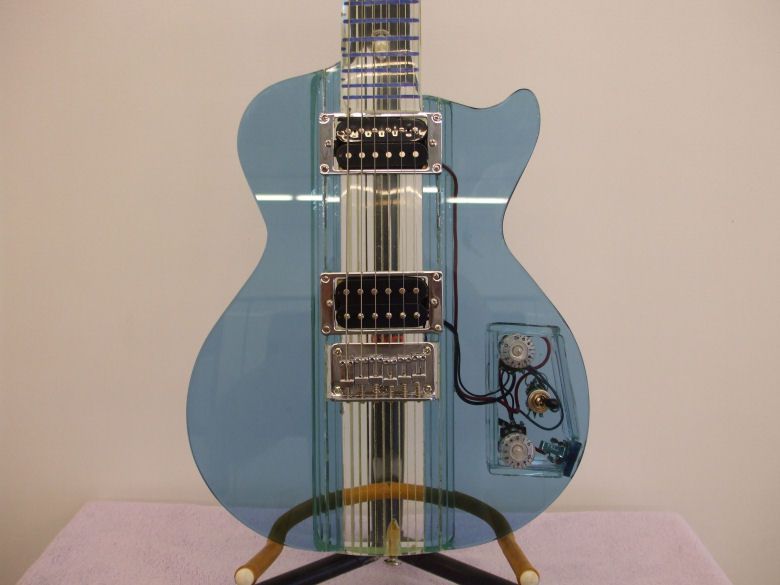
G L Wilson
NB: Please make sure you are reading this Guitarz post at guitarz.blogspot.com and not on a Scraper blog that copies posts without permission (and steals bandwidth) so as to profit from advertising. Please support original bloggers!
Hoyer Jazz Guitar
bertram
NB: Please make sure you are reading this Guitarz post at guitarz.blogspot.com and not on a Scraper blog that copies posts without permission (and steals bandwidth) so as to profit from advertising. Please support original bloggers!
Sunday, 21 February 2010
1959 Framus Tenor Thinline 'Peter Kraus'
bertram
NB: Please make sure you are reading this Guitarz post at guitarz.blogspot.com and not on a Scraper blog that copies posts without permission (and steals bandwidth) so as to profit from advertising. Please support original bloggers!
Hagstrom/Goya - blue glitter, pearloid and perspex
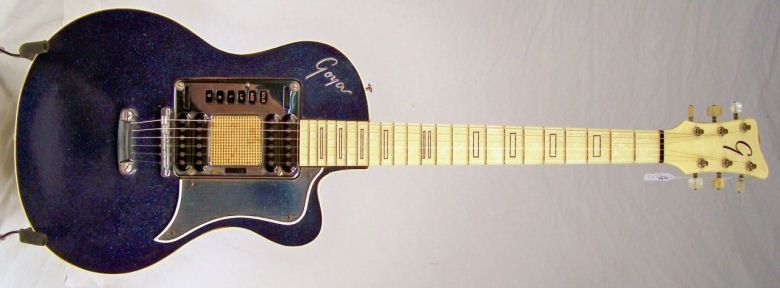 This early 1960s' blue glitter-topped Hagstrom bears the Goya brandname as it is an example of this guitar that was produced for the US market. I believe it's a Deluxe EDP 80 as used by Bryan Ferry in Roxy Music, but the exact names and model numbers can be confusing.
This early 1960s' blue glitter-topped Hagstrom bears the Goya brandname as it is an example of this guitar that was produced for the US market. I believe it's a Deluxe EDP 80 as used by Bryan Ferry in Roxy Music, but the exact names and model numbers can be confusing. All the quirky features are there: the metal plate surrounding the pickups; the pushbutton selector switches; the radio-style grill between the pickups; the perspex fingerboard and headstock with pearloid backing. Although you can't see it in the photos here, the back and sides are also finished in pearloid. It's definitely a guitar that makes a statement!
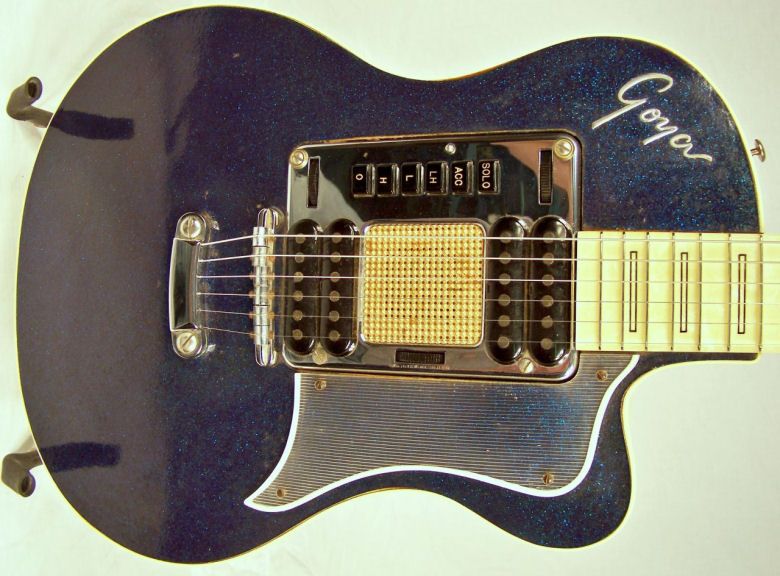 This guitar is one of the 500 listed in the "500 Guitars" book, but alas the publisher was unable to turn up a photo of it, so I'm making up for it here!
This guitar is one of the 500 listed in the "500 Guitars" book, but alas the publisher was unable to turn up a photo of it, so I'm making up for it here!G L Wilson
NB: Please make sure you are reading this Guitarz post at guitarz.blogspot.com and not on a Scraper blog that copies posts without permission (and steals bandwidth) so as to profit from advertising. Please support original bloggers!
Saturday, 20 February 2010
When relics go bad... Mexican Tele abused with power tools
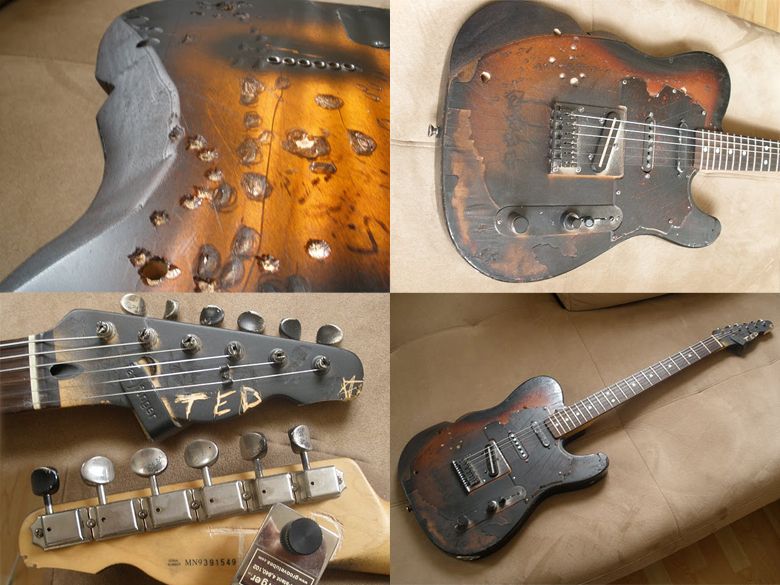 I was going to just let the pictures do the talking, but I want to quote from the eBay listing of this very sorry-looking Telecaster:
I was going to just let the pictures do the talking, but I want to quote from the eBay listing of this very sorry-looking Telecaster: You are bidding on a very cool guitar. [Who says I'm bidding? I was just LOOKING! - GLW] It's (sic) name is TED. Once it was a boring, almost offensive Mexican Telecaster with a Fishman Bridge. Now it is an edgy monster of a Telecaster that will get you more compliments than you can imagine. This guitar is in perfect working condition despite its appearance. It was disassembled, decorated, and then put back together with a stacked humbucker in the bridge position. I believe the middle and neck pickup are original. You can obtain an acoustic-electric tone with the Fishman, a traditional Telecaster tone, or both at once. Included in this package is a special sustain enhancing device attached to the headstock, the Fat Finger, made by Groovetube. It doesn't actually increase sustain, but it is a good conversation starter. Enjoy bidding on what some consider a work of art.... and yes, that belly cut was done with a sawzall. This guitar does currently need to be setup, but will play great once it is. A fender gig bag is included in the sale.
Truly dreadful.
What kind of compliments is this seller speaking of? "Hey buddy, you made a good ol' mess of that guitar with your electric drill, didn't ya?"
I would find the comment about the Fat Finger sustain device not helping with sustain but being a "conversation starter" hysterical, if I wasn't so appalled at the gross incompetence so clearly on display here.
G L Wilson
NB: Please make sure you are reading this Guitarz post at guitarz.blogspot.com and not on a Scraper blog that copies posts without permission (and steals bandwidth) so as to profit from advertising. Please support original bloggers!
An Interview with Vintage Guitar Restorer and Historian Richard Johnston
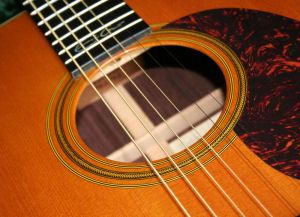 guitarz.blogspot.com:
guitarz.blogspot.com:If you've ever wondered about the history of the guitar, how the instrument first gained popularity and where the likes of the Hawaiian guitar, mandolin and ukulele all fit into the picture, then you could do a lot worse than to read this Interview with Vintage Guitar Restorer and Historian Richard Johnston courtesy of Collector's Weekly. Absolutely facinating stuff.
G L Wilson
NB: Please make sure you are reading this Guitarz post at guitarz.blogspot.com and not on a Scraper blog that copies posts without permission (and steals bandwidth) so as to profit from advertising. Please support original bloggers!
Friday, 19 February 2010
Vintage Gretsch tenor guitar from 1963
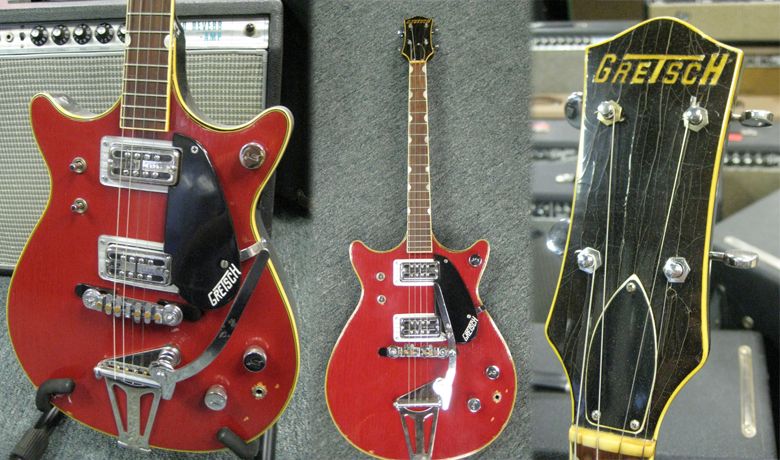 There was a time when big name manufacturers such as Martin, Gibson, Epihone and Gretsch would produce tenor versions of their popular six-string guitars. Pictured above is a Gretsch George Gobel Model tenor guitar from 1963. By the 1970s most manufacturers had more or less abandoned production of niche instruments such as this.
There was a time when big name manufacturers such as Martin, Gibson, Epihone and Gretsch would produce tenor versions of their popular six-string guitars. Pictured above is a Gretsch George Gobel Model tenor guitar from 1963. By the 1970s most manufacturers had more or less abandoned production of niche instruments such as this.I have to confess that I didn't know who George Gobel was, so I had to look him up. It seems bizarre to think that a large manufacturer such a Gretsch had a signature model for a comedian and TV presenter! These days that would be so uncool. Gibson also had a George Grobel model, the L-5CT archtop.
Thanks again to Doug Barker for drawing my attention to this eBay find.
G L Wilson
NB: Please make sure you are reading this Guitarz post at guitarz.blogspot.com and not on a Scraper blog that copies posts without permission (and steals bandwidth) so as to profit from advertising. Please support original bloggers!
1973 Jolana Iris Thinline
NB: Please make sure you are reading this Guitarz post at guitarz.blogspot.com and not on a Scraper blog that copies posts without permission (and steals bandwidth) so as to profit from advertising. Please support original bloggers!
Thursday, 18 February 2010
Bizarre electric tenor guitar... or is it an electric banjo?
 Guitarz reader Doug Barker brought this very strange 4-string electric to my attention.
Guitarz reader Doug Barker brought this very strange 4-string electric to my attention.It has a 27" scale, and so is much longer than a tenor guitar which tend to have a scale length between 21 and 23".
I wonder if the neck has come from a 5-string banjo because of its length and because of the headstock shape (although it looks like a piece has broken off). However, it doesn't have the fifth string or the "step" in the neck at the fifth fret where the extra machine head would be located. It's possible that the neck has been reworked to give it an even taper along its length.
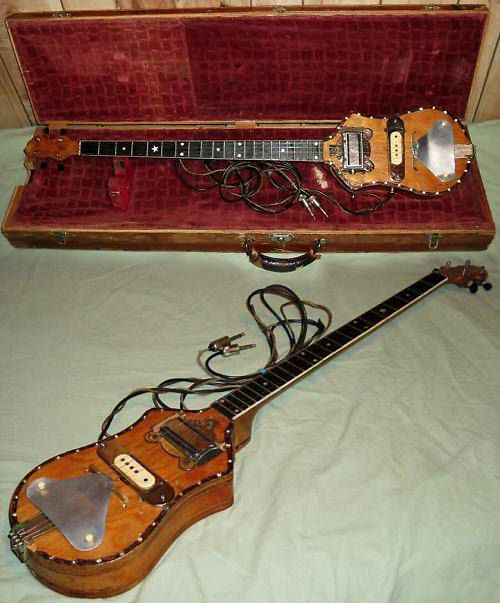 The guitar is fitted with two pickups each of which has its own output lead. These would be the kind of magnetic pickups designed to be used on a flat-top acoustic. The rear pickup is quite a sought-after DeArmond unit (in fact, the same unit that John Martyn used to have on his Martin acoustic. I never did understand, by the way, the reason that there is a polepiece missing in the B-string position. Does anyone know?).
The guitar is fitted with two pickups each of which has its own output lead. These would be the kind of magnetic pickups designed to be used on a flat-top acoustic. The rear pickup is quite a sought-after DeArmond unit (in fact, the same unit that John Martyn used to have on his Martin acoustic. I never did understand, by the way, the reason that there is a polepiece missing in the B-string position. Does anyone know?).As this is a one-off instrument (apparently having belonged to the seller's grandfather), it's very likely that it was tuned to the player's own requirements and it doesn't necessarily have to adhere to the conventions of guitar, tenor guitar or banjo. Those are just labels that are convenient to help our own understanding.
G L Wilson
NB: Please make sure you are reading this Guitarz post at guitarz.blogspot.com and not on a Scraper blog that copies posts without permission (and steals bandwidth) so as to profit from advertising. Please support original bloggers!
Martin Cole Solid Acoustic
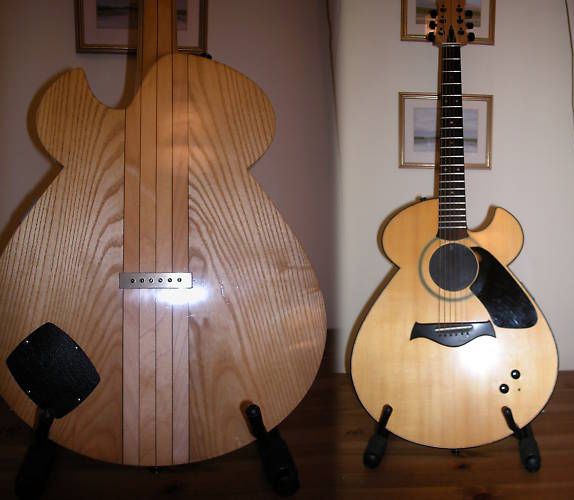 guitarz.blogspot.com:
guitarz.blogspot.com:Here's a one-off solid-bodied acoustic guitar from UK luthier Martin Cole and which is currently for sale on eBay. "Solid-body acoustics" are of course really electric guitars designed to reproduce an acoustic sound, usually for live performance. The advantage they have over a real acoustic miked up or equipped with pickups is, of course, that they are not vulnerable to feedback. (I remember once trying to play my Eko Ranger XII at volume in a live band situation. The feedback nearly shook it to pieces.)
Many "solid acoustics" on the market retain the aesthetics of a genuine acoustic guitar so you get features such as fake soundholes, and indeed we see one of those here on this Martin Cole guitar. However, I like the fact that the guitar shape is highly stylized, as if the design itself is acknowledging the guitar's hybrid elecric/acoustic nature.
All in all, a very nice piece. Such a shame that the current seller has to part with it because the onset of arthritis means that the guitar doesn't get played.
G L Wilson
NB: Please make sure you are reading this Guitarz post at guitarz.blogspot.com and not on a Scraper blog that copies posts without permission (and steals bandwidth) so as to profit from advertising. Please support original bloggers!
Wednesday, 17 February 2010
Jacobacci Tenor Guitar
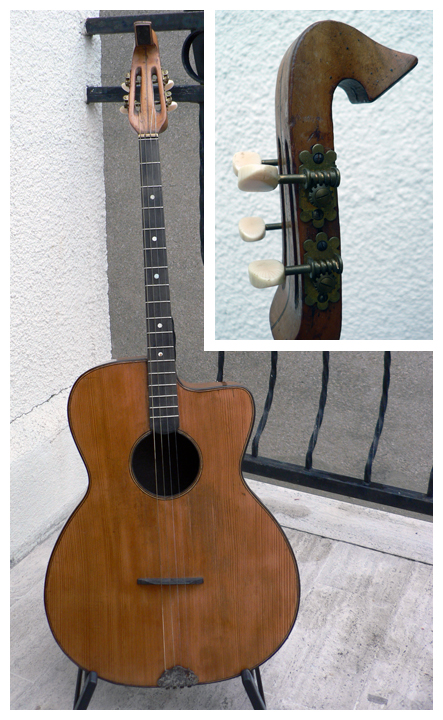
NB: Please make sure you are reading this Guitarz post at guitarz.blogspot.com and not on a Scraper blog that copies posts without permission (and steals bandwidth) so as to profit from advertising. Please support original bloggers!
Goya solidbody with a possible Martin connection
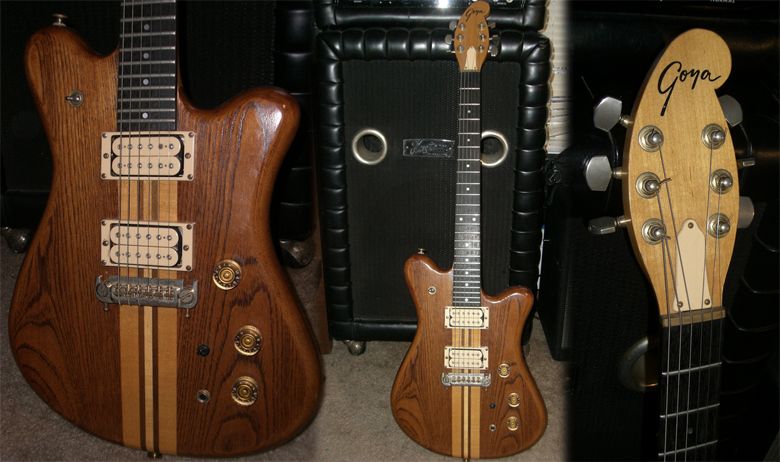 We've had another email, as follows:
We've had another email, as follows: Hey - was wondering if you or your audience could give me any info on this guitar.My own understanding of the Goya brand, was that it was just that - a brandname used to sell guitars in the United States. For example, Sweden's Hagstrom guitars were re-badged "Goya" for the US market.
I picked this up a couple years ago, and don't know much about it. It's a Goya that looks very similar to a Martin E-18, which from what I can tell is their only foray into solid body electrics. I've seen these online with headstocks labeled EF Martin, Sigma Martin, but never Goya. It's my understanding that Goya was bought by Martin at some point in the late 70s, so I'm guessing the E-18 was just a rebranding of this Goya model? I don't know. It's a great sounding and playing guitar, never seen another one though.
Thanks in advance!
-Tim
I think you may have (semi)-answered your own question, Tim. That it was a brandname bought out by Martin. Perhaps they badged their own electric solidbodies with the Goya brandname because the Martin name was so firmly established in everyone's mind as being an acoustic brand. That the guitars also appeared branded Martin and Sigma suggests different marketing strategies at different timess, perhaps?
If anyone else reading has any more info, please let us know!
G L Wilson
NB: Please make sure you are reading this Guitarz post at guitarz.blogspot.com and not on a Scraper blog that copies posts without permission (and steals bandwidth) so as to profit from advertising. Please support original bloggers!
Tuesday, 16 February 2010
Ladies of the silver screen on a sawn-off Strat
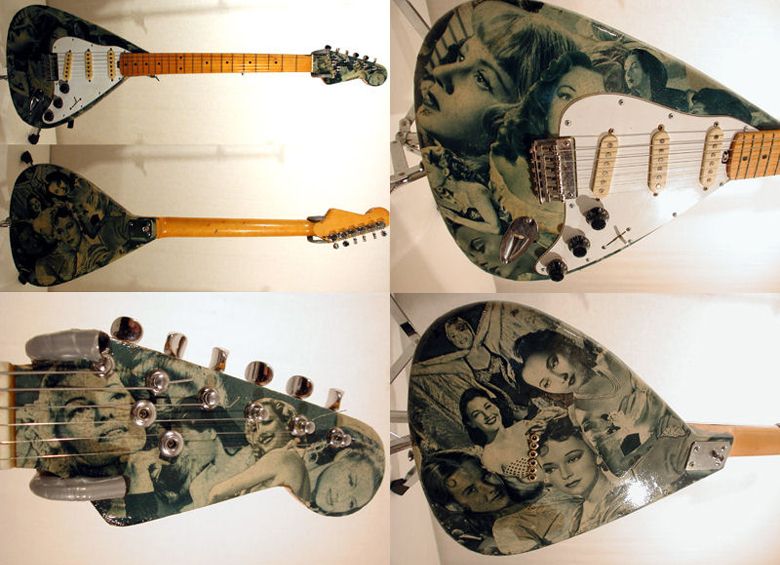 This teardrop-shaped guitar looks like a Strat with the horns sawn off, although the shape isn't quite right for that. (A sawn-off Kawai Aquarius, perhaps?)
This teardrop-shaped guitar looks like a Strat with the horns sawn off, although the shape isn't quite right for that. (A sawn-off Kawai Aquarius, perhaps?)The guitar has been adorned on front, back and headstock with images of female movie stars from post-war cinema. The images - cut from magazines, I guess - are sealed beneath five layers of varnish. Unfortunately I can't tell you who's who, because this is not my area of expertise.
G L Wilson
NB: Please make sure you are reading this Guitarz post at guitarz.blogspot.com and not on a Scraper blog that copies posts without permission (and steals bandwidth) so as to profit from advertising. Please support original bloggers!
Hutchins sextuple-necked guitar/bass
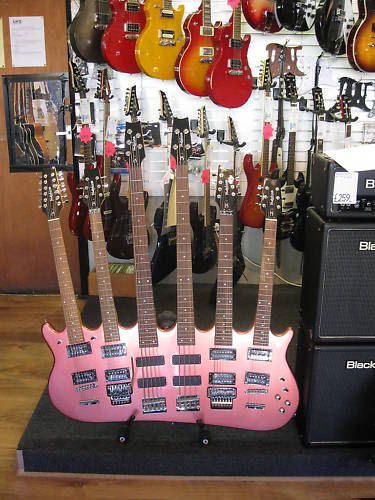 guitarz.blogspot.com:
guitarz.blogspot.com:We've looked at this beast before. Just two years ago this ridiculous instrument was selling for £549 - now it's being listed at £899. That's inflation for you!
It's also a lot of money to spend on an "instrument" that is more or less a display item. Let's face it, it's not really going to be possible to even reach let alone play any of the lower three necks, and even if you just played the uppermost necks, can you imagine the weight and sheer awkwardness of that thing?
You could use it as a stage prop perhaps, just on the one song, but even then it's going to be an inconveniently-shaped piece of gear to cart around to gigs. It'd need one hell of a flightcase. I believe it only comes with a tent-like "gig bag" (see previous post on this guitar).
This seller suggests that even if you can't play all six necks it would still make a good "wall peice" (sic). I don't know about you, but if I hung that up in my house, I'd be worried about it bringing the whole wall down.
G L Wilson
NB: Please make sure you are reading this Guitarz post at guitarz.blogspot.com and not on a Scraper blog that copies posts without permission (and steals bandwidth) so as to profit from advertising. Please support original bloggers!
Fano Alt De Facto SP6 Rustbucket
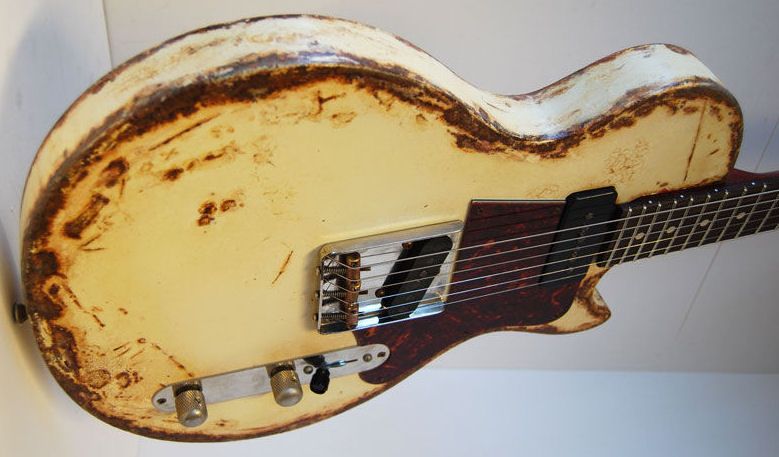 This guitar, looking like a cross between a Les Paul Junior and a Telecaster, is a Fano Alt De Facto SP6 Rustbucket. It's easy to see where is gets its name from, for it is finished in a distressed "rusted" fashion. Of course, James Trussart's rusty steel-bodied guitars spring immediately to mind, but the curious thing about the Rustbucket is that it is not metal-bodied at all. The body is actually alder with a spruce top.
This guitar, looking like a cross between a Les Paul Junior and a Telecaster, is a Fano Alt De Facto SP6 Rustbucket. It's easy to see where is gets its name from, for it is finished in a distressed "rusted" fashion. Of course, James Trussart's rusty steel-bodied guitars spring immediately to mind, but the curious thing about the Rustbucket is that it is not metal-bodied at all. The body is actually alder with a spruce top.
To my way of thinking that is a bit odd. If I wanted a rusty guitar, I'd want it to be metal. I have to say, though, that I prefer shiny metal bodies. Each to their own, I suppose.
For more Fano guitars, please see: www.fanoguitars.com
G L Wilson
NB: Please make sure you are reading this Guitarz post at guitarz.blogspot.com and not on a Scraper blog that copies posts without permission (and steals bandwidth) so as to profit from advertising. Please support original bloggers!
Monday, 15 February 2010
Aria Pro II Urchin U70

Bertram
NB: Please make sure you are reading this Guitarz post at guitarz.blogspot.com and not on a Scraper blog that copies posts without permission (and steals bandwidth) so as to profit from advertising. Please support original bloggers!
Stroup Tele that thinks its a Jag
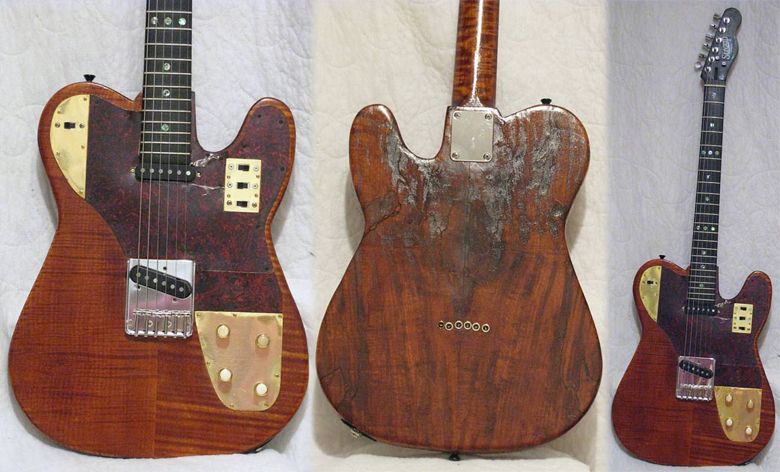 This is a handmade T-type guitar from Stroup Guitars currently being offered for sale on eBay. Made from Canadian Maple and with solid brass metalwork, by the maker's own admission it looks a little rough round the edges, rugged even, but I think this is part of its charm. The maker also mentions that he was inspired to build this having played a Jag for many years, and indeed this guitar does feature metal plates and Jaguar-like controls. Whether these controls include the Jaguar's now legendary "strangle switch", I couldn't say. Also it's a shame there's no Jag-style trem.
This is a handmade T-type guitar from Stroup Guitars currently being offered for sale on eBay. Made from Canadian Maple and with solid brass metalwork, by the maker's own admission it looks a little rough round the edges, rugged even, but I think this is part of its charm. The maker also mentions that he was inspired to build this having played a Jag for many years, and indeed this guitar does feature metal plates and Jaguar-like controls. Whether these controls include the Jaguar's now legendary "strangle switch", I couldn't say. Also it's a shame there's no Jag-style trem.
G L Wilson
NB: Please make sure you are reading this Guitarz post at guitarz.blogspot.com and not on a Scraper blog that copies posts without permission (and steals bandwidth) so as to profit from advertising. Please support original bloggers!
Sunday, 14 February 2010
Seeing as it's (St) Valentine's Day...
 Anyone who knows me will know how cynical I am about days like these - "Valentines Day" (sic) - which are a modern media-controlled corruption of an old folk tradition. Saint Valentine's Day (to give it its correct title) used to be all about a sending anonymous cards and gifts to someone that you secretly admired, but now it's just another corporate extolled greed-fest, the sole aim of which is to spend spend spend to show your loved one that you really can be romantic at least one day out of 365.
Anyone who knows me will know how cynical I am about days like these - "Valentines Day" (sic) - which are a modern media-controlled corruption of an old folk tradition. Saint Valentine's Day (to give it its correct title) used to be all about a sending anonymous cards and gifts to someone that you secretly admired, but now it's just another corporate extolled greed-fest, the sole aim of which is to spend spend spend to show your loved one that you really can be romantic at least one day out of 365.Sorry, I went off onto a bit of a rant there.
But, despite such cynicism, the above guitar is too good to miss out on, because today of all days it is topical. It's another of Maccaferri's wonderful plastic guitars, this model being called The Romancer. These guitars were originally produced in 1953 and - despite their toy-like appearance - were intended as serious highly-functional instruments. I expect that with this particular model you were encouraged to serenade your loved one, as depicted in the images on its top.
Read more about Macceferri's plastic guitars and ukuleles here.
G L Wilson
NB: Please make sure you are reading this Guitarz post at guitarz.blogspot.com and not on a Scraper blog that copies posts without permission (and steals bandwidth) so as to profit from advertising. Please support original bloggers!
Vigier Marilyn
Another guitar that I'd love to see in natural oiled finish!
bertram
NB: Please make sure you are reading this Guitarz post at guitarz.blogspot.com and not on a Scraper blog that copies posts without permission (and steals bandwidth) so as to profit from advertising. Please support original bloggers!
Saturday, 13 February 2010
Eastwood Airline with Jaguar trem
So this guitar has the chambered mahogany body and the humbuckers specific to the Eastwood Airline model (opposed to the "Res-O-Glas" body and wide single coil pickups of the original Airlines), but is another step away from the old school one with the addition of a Jaguar trem (Eastwood usually use Bigsby trems, but don't have them on the 2P models) and a new bigger custom pickguard.
But you know, who cares about original model, when you made the guitar that suits you!
NB: Please make sure you are reading this Guitarz post at guitarz.blogspot.com and not on a Scraper blog that copies posts without permission (and steals bandwidth) so as to profit from advertising. Please support original bloggers!
70s Hoyer Les Paul close-up
Friday, 12 February 2010
Roberts Tezuka
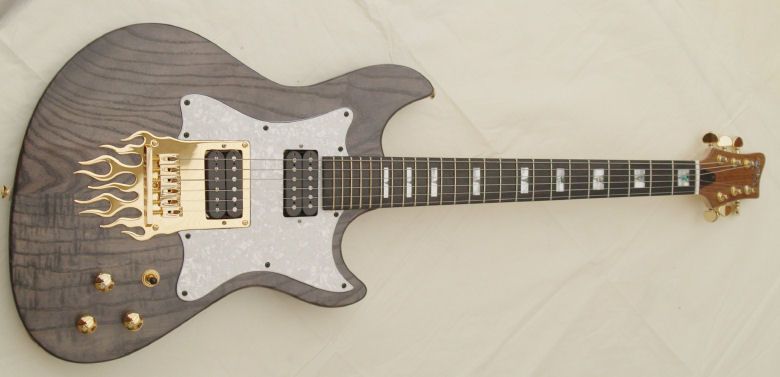 I've had an email from Vaughn who asks if I am aware of Roberts Guitars, a small company producing original quality guitars right here in the UK, in Bristol, to be precise.
I've had an email from Vaughn who asks if I am aware of Roberts Guitars, a small company producing original quality guitars right here in the UK, in Bristol, to be precise.Well, yes, I am aware of them and have been meaning to feature them on this blog for a very long time. I'm always very keen to feature our own "home-grown" guitars if I am able.
Pictured above is Vaughn's own Roberts Tezuka. He writes that:
"Its got different pickups than the majority of the ones they made - I wanted more vintagey pickups and Roberts obliged.It certainly is a looker! The Tezuka features a hand-cut hand-finished body of solid ash (alder is also available) married to a set-neck of maple topped by an ebony fingerboard with hand inlaid custom markers. The headstock is topped with walnut and features Roberts' own fine tune machine heads. Pickups would ordinarily be Roberts' custom-wound Z2 Power Pro split rails; however it's nice to know that they were happy to oblige with the request for vintage pickups instead. Electrics comprise two volumes, one tone and a three-way selector switch, with a coiltap being offered as an option.
The finish is described as "burnt chocolate matt" and the pictures don't do it justice... got a really nice sheen to it. The guitar weighs more than a Les Paul but I find it comfortable enough for prolonged playing and the density adds to the tone and sustain considerably."
G L Wilson
NB: Please make sure you are reading this Guitarz post at guitarz.blogspot.com and not on a Scraper blog that copies posts without permission (and steals bandwidth) so as to profit from advertising. Please support original bloggers!
1975 Eko Kiwi
Bertram
NB: Please make sure you are reading this Guitarz post at guitarz.blogspot.com and not on a Scraper blog that copies posts without permission (and steals bandwidth) so as to profit from advertising. Please support original bloggers!
Thursday, 11 February 2010
Duesenberg 49er
NB: Please make sure you are reading this Guitarz post at guitarz.blogspot.com and not on a Scraper blog that copies posts without permission (and steals bandwidth) so as to profit from advertising. Please support original bloggers!
1970 Ampeg Dan Armstrong
Wednesday, 10 February 2010
Vintage Japanese Teicso Bass
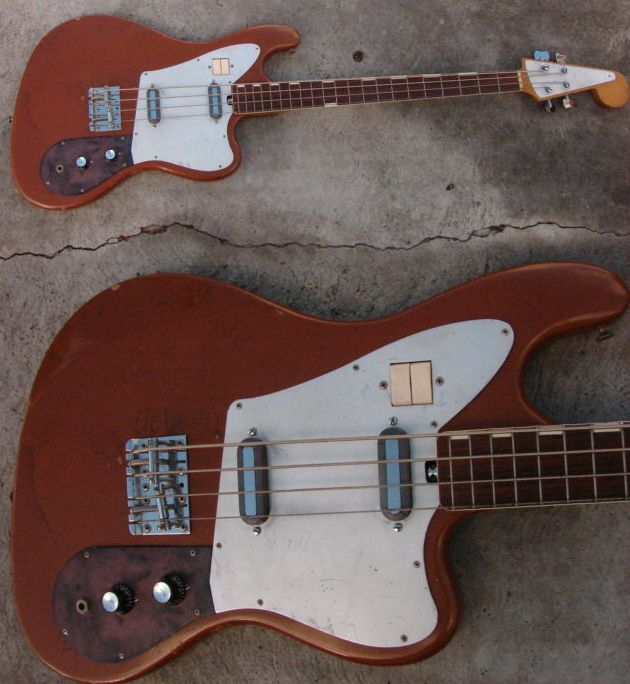 guitarz.blogspot.com:
guitarz.blogspot.com:This bass, although unbadged, is quite unmistakably a Teisco, namely an NB-4, a model which dates back to 1965. It's not as sexy as the Teisco 6-string bass that we looked at last year, but you'll notice from the obvious similarities between the two that they are sibling models.
I particularly like the headstock. It looks like the design was based on the famous Fender headstock shape, but then they ignored the shape and arranged the tuners above and below in the classsic 2+2 layout.
Judging by the position of the bridge it must surely be a short-scale bass, but the elongated body and huge headstock make you think at first glance that it ought to be a long-scale.
G L Wilson
NB: Please make sure you are reading this Guitarz post at guitarz.blogspot.com and not on a Scraper blog that copies posts without permission (and steals bandwidth) so as to profit from advertising. Please support original bloggers!
Mickey Mouse Club Tenor "Mousegetar"
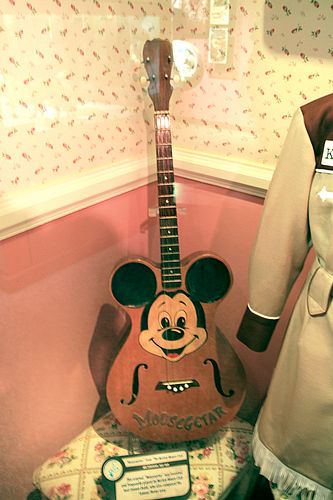 guitarz.blogspot.com:
guitarz.blogspot.com:Hello GL, from snowy and cold Washington DC, where we're about to break our all-time record for snowfall amounts by Wednesday morning.Thanks for that, Alan. When I first saw the photo, I thought that the mouse ears were the soundholes (similar to the "modern" idea of positioning a large soundhole to the left and/or right of the neck on acoustic guitars) but on viewing the YouTube video below I see this is not the case.
A guitar that's quite a curiosity is this nearly 60-year-old relic from American television's "Mickey Mouse Club" -- the original tenor "Mousegetar", played by host Jimmie Dodd. This particular instrument is in the Disney Museum in California, and the photo is credited to Megan Duffy, posting on Flickr.
The curiosity is that no one seems to know who built this guitar; whether it was a private luthier, the props department from the Disney organization, or a commercial maker preferring to remain anonymous. This is a perfectly playable instrument and can be seen in web videos from the old Mickey Mouse Club.
Disney manufactured plastic toy copies of this tenor guitar, but this one remains the "cool one". If your followers can contribute any info on this guitar, have at it.
Regards,
Alan Peterson
Broadcast Engineer & Proud Gretsch Owner
Washington DC
G L Wilson
UPDATE (15 December 2011) - Carl writes:
Since Disneyland was in Southern California a nearby luthier was sought out to build a guitar for the Mickey Mouse Club show. They had to look no further than Brooklyn Street (since renamed Caesar Chavez Avenue) in Los Angeles.NB: Please make sure you are reading this Guitarz post at guitarz.blogspot.com and not on a Scraper blog that copies posts without permission (and steals bandwidth) so as to profit from advertising. Please support original bloggers!
Two brothers, Porfirio and Candalario Delgado sold guitars they had hand made in Juarez and Tijuana Mexico and they were very successful. They moved their business to Los Angles in 1948 and opened a store called Los Hermanos Candalas where they manufactured and sold their handmade custom guitars. They developed an excellent reputation. Disney Productions asked Candalario, known as Candalas, to build the Mickey Mouse Guitar to their specifications. In fact the store is still there and still selling wonderful hand made guitars and Latin string instruments.
Tuesday, 9 February 2010
Headless lute-style roundback nylon-strung guitar
 The guitar that I found in this eBay listing is a complete mystery to me. I think I just about said it all there in the title - it's a headless lute-style roundback nylon-strung guitar, and it's acoustic. From the photos it does look pretty old, but how old? There really is no way of telling. The only thing that could offer a clue is the presence of Grover tuners, but even that's not saying much as tuners are easily replaced.
The guitar that I found in this eBay listing is a complete mystery to me. I think I just about said it all there in the title - it's a headless lute-style roundback nylon-strung guitar, and it's acoustic. From the photos it does look pretty old, but how old? There really is no way of telling. The only thing that could offer a clue is the presence of Grover tuners, but even that's not saying much as tuners are easily replaced.The seller mentions that:
"These vintage guitar-lutes where most common in Germany during the late 1880s to about the 1920s. This era was called the wondervogel movement..."...but would this particular instrument have come from that era? I'm particularly interested in the headless design and am wondering what were the very first ever headless guitars (or guitar-like instruments)? I know that, contrary to popular belief, Steinberger wasn't the first, but just how far back does the concept actually go?
G L Wilson
NB: Please make sure you are reading this Guitarz post at guitarz.blogspot.com and not on a Scraper blog that copies posts without permission (and steals bandwidth) so as to profit from advertising. Please support original bloggers!
Kustom K-100 amp and speaker cab
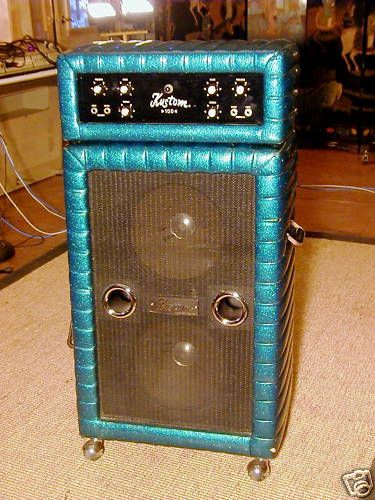 guitarz.blogspot.com:
guitarz.blogspot.com:Several of you correctly identified the Kustom Kat in our quiz last week.
Kustom Amplification were founded in 1966 and their solid-state amps were quite eye-catching being covered in Tuck-And-Roll naugahyde, similar to automobile upholstery of the era. Colours included Red Sparkle, Blue Sparkle, Gold Sparkle, Cascade Sparkle (Teal), Charcoal Sparkle, Silver Sparkle, and Flat Black (no sparkle).
The Kustom Kat was a promotional item originally given away with purchased Kustom amps and were available in the same colours. They were similar to the naugas, supposedly being the creature from which naugahyde comes from. (Apparently naugas shed their skins naturally and - luckily for them - no naugas were killed for their skin in order to make naugahyde!)
Pictured here is a Kustom K-100 amp and speaker cab in Cascade Sparkle. This amp is currently for sale on eBay, but the seller doesn't mention there being a matching Kustom Kat.
The Kustom Kats themselves are quite collectable. The one we looked at in the quiz is currently for sale on eBay with a starting price of $295.95 - I'm told these can sometimes fetch up to $1,000.
G L Wilson
NB: Please make sure you are reading this Guitarz post at guitarz.blogspot.com and not on a Scraper blog that copies posts without permission (and steals bandwidth) so as to profit from advertising. Please support original bloggers!
Monday, 8 February 2010
Kawai Moonsault with gigbag
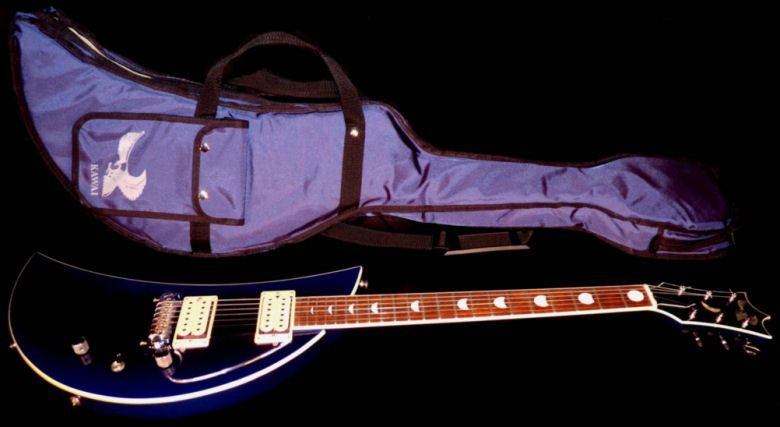 We've previously looked at the Kawai Moonsault on this blog (see here), but I think it's well worth another look because it's one of my all-time favourite designs and is one that is rarely seen outside of Japan. This particular blue-burst example is available for sale on eBay right now, priced at $3995, so as much as I love this design I'm not going to be buying one any time soon.
We've previously looked at the Kawai Moonsault on this blog (see here), but I think it's well worth another look because it's one of my all-time favourite designs and is one that is rarely seen outside of Japan. This particular blue-burst example is available for sale on eBay right now, priced at $3995, so as much as I love this design I'm not going to be buying one any time soon.Furthermore, I had to show you the above photo, because it's rare enough to see a Moonsault itself, let alone its oddly-shaped gigbag. I bet you'd get a few stares carrying one of those.
G L Wilson
NB: Please make sure you are reading this Guitarz post at guitarz.blogspot.com and not on a Scraper blog that copies posts without permission (and steals bandwidth) so as to profit from advertising. Please support original bloggers!

